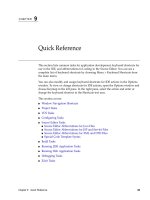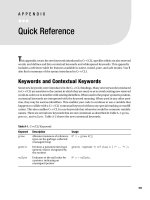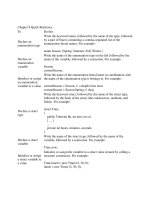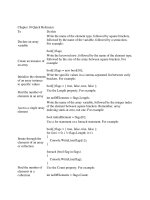Lean excel top functions quick reference guide with 500 examples by scott ratliff
Bạn đang xem bản rút gọn của tài liệu. Xem và tải ngay bản đầy đủ của tài liệu tại đây (425.07 KB, 147 trang )
LeanExcel:TopFunctions
ByScottRatliff
www.LeanExcelBooks.com
LegalStuff
Copyright©2015byScottRatliff
Allrightsreserved.Nopartofthisebookmaybereproducedortransmittedinanyform
orbyanymeanswithoutwrittenpermissionfromthepublisher.
Allbrandnamesandproductnamesusedinthisbookaretradenames,servicemarks,
trademarks,orregisteredtrademarksoftheirrespectiveowners.ScottRatliffisnot
associatedwithanyproductorvendormentionedinthisbook.
Introduction
Knowinghowtousethebuilt-infunctionsinMicrosoftExcelwillturnyouintoa
poweruser!Therearehundredsoffunctionsandatfirst,thelistcanseemoverwhelming.
EvenasaMicrosoftOfficeExpertinExcel2013IdonotknowalloftheExcelfunctions
available.InwritingthiseBook,IdiscoveredseveralnewfunctionsthatIhavenow
incorporatedintomydailyuseandhavemademydataanalysismoreefficient.Ihopethat
thiseBookwillhelpyoulearnmoreoftheExcelfunctionsandthattheywouldhelpyou
gaincontroloveryourspreadsheets!
WhyLeanExcel?
ThisLeanExcelseriesfocusesontime-savingtoolsthatwillhelpyoureducethe
wasteassociatedwithdataanalysis.Oneofthetenetsofleanmanufacturingtheoryis
usingspecializedtoolstoaccomplishatask.Youcoulduseawrenchtodriveanailbuta
hammerwillgetthejobdonemuchfaster.Remembertimeismoney.
Thinkofthebuilt-infunctionsasspecializedtools.Let’ssayyouneededtofindthe
averageofadatasetthatisinA1throughA5.Remembertheaverageisthesumofallthe
numbersinadatasetdividedbythecountofnumbersinthatdataset.Let’slookatthree
waystofindtheaverage.First,youcouldusetheformula=(A1+A2+A3+A4+A5)/5.
Second,youcouldusetheSUMandCOUNTfunctions=SUM(A1:A5)/COUNT(A1:A5).
Orlastly,youcouldusetheAVERAGEfunction=AVERAGE(A1:A5).Althoughallthree
optionsgiveyouthesameanswer,usingtheAVERAGEfunctionisclearlythemost
efficient.ButinordertousetheAVERGEfunction,youneedtoknowthatitexistsand
whatrequirementsyouneedtouseit.
EnteringFormulasandFunctions
First,let’sidentifythesimilaritiesbetweenformulasandfunctions.Bothformulas
andfunctionscanbeenteredusingtheformulabarimmediatelybelowtheExcelRibbon.
TheExcelRibbonisthehorizontalbarnearthetopoftheExcelwindowthatcontainsall
ofthebuttonsfortoolsavailableinExcel.Bothformulasandfunctionsbeginwiththe
equalssign(=).Thisisrequiredonlyatthebeginningoftheformulabar;itisnotrequired
beforeeachindividualfunctionwithinthatcell.TheequalssigntellsExcelthatyouwant
Exceltodoacalculationforthiscell.Ifyoudidnothavetheequalssign,thenExcelwill
putexactlywhatyoutypeintothatcell.
Next,let’sidentifythedifferencebetweenafunctionandaformula.Inthefirst
sectionofthisbook,wediscussed3waystofindtheaverageoffivenumbers.Thefirst
optionisanexampleofaformula.Itbeginswithanequalssign(=)andincludes
mathematicoperators(addition:+,subtraction:-,multiplication:*,division:/).Asseenin
thefirstoption=(A1+A2+A3+A4+A5)/5,itcanincludebothreferencestocells(A1,A2,
A3,etc.)andactualnumbers(the5afterthedivisionsign).Aformulacanincludeother
mathematicoperatorssuchasparentheses()todeterminetheorderofoperationsand^for
exponents.Excelfollowsthesameorderofoperationsyoulearnedinalgebra:
Parenthesesthenexponentsthenmultiplicationanddivisionandlastlyadditionand
subtraction.Soifyouentered=(2+3)^2/5+1intoacellinExcel,itwouldfirstdowhat
wasintheparentheses(2+3)=5.Nextitwouldlookforexponentsso(5)^2=25.Thenit
wouldlookformultiplicationordivision25/5=5andlastlyadditionorsubtraction5+1=
6.So6wouldbetheresultoftheformulaandbedisplayedinthecell.
Afunctionisenteredverysimilarlybutusesabuilt-inkeywordthatExcelwill
recognize.ThethirdoptionfromtheprevioussectionusestheAVERAGEfunction.To
enterthefunction,firstputanequalssign(=)thentypethefunctionname.Excelwilltry
torecognizethekeywordyouaretypingandprovideyoualistofthefunctionsthatbegin
withwhatyoutyped.Youcaneithercontinuetypingordouble-clickonthefunctionyou
seeinthelist.Whenyoutypethekeyword,uppercaseisnotrequired;however,ifExcel
identifiesthekeywordasafunction,thenitwillconvertittouppercase.Alternatively,
youcouldclickontheFormulatabontheExcelribbonandchooseafunctionfromthe
categorieslistedthere.Forreferenceconsistency,thefunctionsincludedinthiseBookare
dividedtomatchthecategoriesontheFormulastaboftheExcelribbon.
Eachfunctionbeginswiththeequalssign(=)thenthekeyword(AVERAGE,
COUNT,SUM,etc.)andthenanopenparentheses(.Aftertheopenparentheses,Excel
expectsalistofarguments.Thisisthemostconfusingpartofusingafunction.Each
functionrequiresadifferentsetofargumentsandtheargumentsmustmatchcertain
criteriaorthefunctionwillreturnanerror(#ERR,#N/A,#DIV/0,etc.).Inthethirdoption
above,theAVERAGEfunctionrequiredsomenumber,listofnumbers,orrangeasan
argument.WeenteredtherangeA1:A5fortheargument.Weassumedthatrange
containedvalidnumberdata,ifanycellinthatrangeA1:A5containedsomethingbesides
anumber,thenourfunctionmayhaveresultedinanerror.
Youcanalsouseformulasandfunctionstogether.Forexample,thesecondoptionof
theprevioussectionistwofunctions(SUMandCOUNT)inaformula(SUM/COUNT).
Wecoulduseanyofthemathematicoperatorsontheresultofanyfunctionaslongasthe
resultofthatfunctionisanumber.Somefunctionsreturnnon-numericdatasothatmay
resultinanerror.
FunctionArguments
Afewmoredetailsweneedtodiscussbeforewegettothefunctions.Intheprevious
section,wediscussedhowafunctionbeginswithanequalssignthenakeyword,thenan
openparentheses,thenthearguments,andlastlytheclosingparentheses.Somefunctions
suchasTODAY()requiresnoarguments.OtherargumentssuchasSUM,COUNT,
AVERAGErequireoneargumentbutthenallowformanymorearguments.Whenyou
enterafunction,excelshowsyouwhichargumentyouarecurrentlyenteringwiththepopupboxthatappearsbelowtheformulabar.Forexample,fortheSUMfunction,thepopupboxdisplaysSUM(number1,[number2],…).Thenumber1meansitisrequiredbutthe
brackets[]aroundthe[number2]indicateitisoptional.Notethecommaseparatingthe
arguments;whenyouenterafunction,youwillneedtoseparatetheargumentsbya
commatoo.The(…)meansthattherecouldbemanymoreargumentsthatmatchthetype
ofthelastargument.Inthiscase,therecouldbemanymorenumbers([number3],
[number4],etc).
Somefunctionshaveanoptionalpairofarguments.Forexample,theSUMIFS,
COUNTIFS,andAVERAGEIFSfunctionsallhavethearguments[criteria_rangeX,
criteriaX]whereXisthenextnumberinseries.Sincethebracketisaroundthepairor
arguments,thepairisoptionalbutifyouwanttoincludetheargument,thenyoumust
includebothargumentsofthepair.
Mostargumentscouldbefulfilledbyeitheravalueoracellreference.Most
experiencedExcelusersputalloftheargumentsincellsandthenreferencethecells
withintheargumentsofthefunction.Theexampleworkbooksarebuiltthisway.With
thismethod,youcanchangethevalueinthereferencecellsandthefunctionwillthen
changeinsteadofhavingtogointotheformulabarandchangethefunctiondirectly.I
hopeusingthismethodwillhelpyouunderstandtherelationshipbetweentheinputsand
outputsofthefunctionasbothcomponentsarevisible.
ExampleWorkbook
Toreallyunderstandatopic,mostpeopleneedtovisualizeit.Therefore,allofthe
functionsdiscussedinthiseBookareincludedinaworkbookwithover500examples.
YoucanfindtheexampleworkbookandVisualAidprintoutsatthelinkbelow.
Tohelpvisualizetheinputs,somefunctionsthatrequirearangehavetherange
addresssavedinacell.Theninthefunction,I’veaddedtheINDIRECTfunctionto
converttherangeaddresssavedinthecelltotheactualrangeofthefunction.For
example,let’ssayB5containstherangeaddress“A2:A4”andA2throughA4containsall
numbers.IfIwastoenterthefunction=SUM(B5),itwouldreturn0becauseB5contains
thetextstring“A2:A4”.Inordertoconvertthetext“A2:A4”intoanaddress,weneedto
addtheINDIRECTfunction.Sothefunctionshouldthenbe=SUM(INDIRECT(B5))
whichisequivalentto=SUM(A2:A4)sinceB5contains“A2:A4”.Theexamplesareset
upthiswaysoyoucanseetheaddressoftherangesthatgointothefunctions.Tochange
theaddress,changeitinthecellwiththeaddress(inthemostrecentexample,thatcell
wouldbeB5).
Findtheexampleworkbookhere:
/>
FunctionGuide
ThisFunctionGuideliststhekeywordthentheargumentsanddescriptionforeach
function.Wheneverthedescriptionreferencesthearguments,theargumentnamewillbe
inbold.Mostdescriptionswillbeginwiththeword“returns.”Theargumentsarethe
inputofthefunctionandthenthefunctionreturnstheoutput.Theoutputisvisibleinthe
cellwhilethefunctionisstillvisibleintheformulabarorbydoubleclickinginthecell.
Somefunctionsinthefunctionguidemustbeenteredasanarray.Toenterafunction
asanarray,holddownthecontrolandshiftbuttonswhilepressingenter(formacusers,
holddowncontrolandshiftwhilepressingreturn).Youwillknowthefunctionwas
enteredasanarraybythecurlybrackets{}aroundthefunctionintheformulabar.Donot
enterthecurlybracketsmanually.
DateFunctions
UsingDatesinExcel
Excelstoresdatesasnumberscalledserialnumbers.Zerocorrespondsto1/1/1904.
Thenumber100refersto100dayssince1/1/1904.Timesarestoredaspartialdays.So
12:00noonishalfthedaysoitisstoredas0.5addedtothedate.
AddingandSubtractingDatesandTimes
Toaddorsubtractadate,justaddorsubtractwholenumbers.Toaddorsubtracta
time,addorsubtractthepartialday.Ifyouwantedtoseewhattimeitwasafter5hours,it
iseasierandmoreexacttoadd5/24toadatethanitistorememberthat5/24=
.208333333.
DATE
Arguments:year,month,day
Description:Returnstheserialnumberofthedateofthespecifiedyear,month,andday.
DAY
Arguments:serial_number
Description:Returnsthedayofthemonth(1-31)oftheserial_number.
DAYS
Arguments:end_date,start_date
Description:Returnsthenumberofdaysbetweenend_dateandstart_date.Equivalentto
end_date-start_date.
EDATE
Arguments:start_date,months
Description:Returnstheserialnumberofthedatethatisthespecifiednumberofmonths
beforeorafterthestart_date.Ifmonthsislessthan0thenitreturnsmonthsbefore;if
greaterthan0thenmonthsafter.
EOMONTH
Arguments:start_date,months
Description:Returnstheserialnumberofthelastdayofthemonththatisthespecified
numberofmonthsbeforeorafterthestart_date.Ifmonthsislessthan0thenitreturns
monthsbefore;ifgreaterthan0thenmonthsafter.
HOUR
Arguments:serial_number
Description:Returnsthehour(0-23)oftheserial_number.
MINUTE
Arguments:serial_number
Description:Returnstheminute(0-59)oftheserial_number.
MONTH
Arguments:serial_number
Description:Returnsthemonth(1-12)oftheserial_number.
NETWORKDAYS
Arguments:start_date,end_date,[holidays]
Description:Returnsthenumberoffullworkdaysbetweenstart_dateandend_date.
Specifythedatesofanyholidaystoexclude.
NOW
Arguments:none
Description:Returnsthecomputer’sdateandtime.









